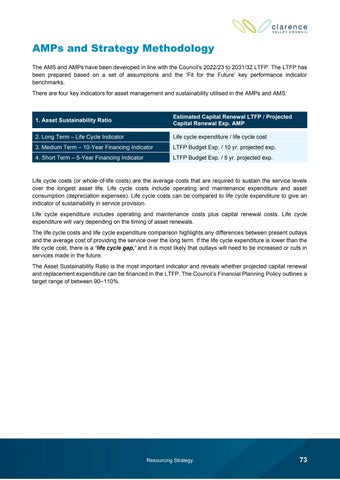AMPs and Strategy Methodology The AMS and AMPs have been developed in line with the Council’s 2022/23 to 2031/32 LTFP. The LTFP has been prepared based on a set of assumptions and the ‘Fit for the Future’ key performance indicator benchmarks. There are four key indicators for asset management and sustainability utilised in the AMPs and AMS:
1. Asset Sustainability Ratio
Estimated Capital Renewal LTFP / Projected Capital Renewal Exp. AMP
2. Long Term – Life Cycle Indicator
Life cycle expenditure / life cycle cost
3. Medium Term – 10-Year Financing Indicator
LTFP Budget Exp. / 10 yr. projected exp.
4. Short Term – 5-Year Financing Indicator
LTFP Budget Exp. / 5 yr. projected exp.
Life cycle costs (or whole-of-life costs) are the average costs that are required to sustain the service levels over the longest asset life. Life cycle costs include operating and maintenance expenditure and asset consumption (depreciation expenses). Life cycle costs can be compared to life cycle expenditure to give an indicator of sustainability in service provision. Life cycle expenditure includes operating and maintenance costs plus capital renewal costs. Life cycle expenditure will vary depending on the timing of asset renewals. The life cycle costs and life cycle expenditure comparison highlights any differences between present outlays and the average cost of providing the service over the long term. If the life cycle expenditure is lower than the life cycle cost, there is a ‘life cycle gap,’ and it is most likely that outlays will need to be increased or cuts in services made in the future. The Asset Sustainability Ratio is the most important indicator and reveals whether projected capital renewal and replacement expenditure can be financed in the LTFP. The Council’s Financial Planning Policy outlines a target range of between 90–110%.
Resourcing Strategy
73




